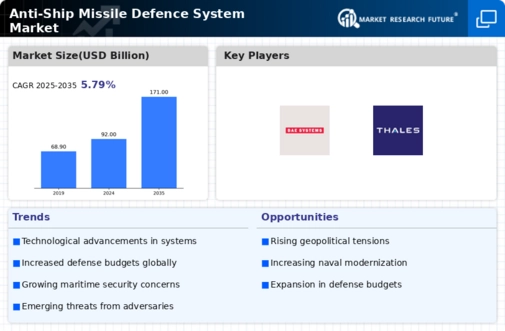Market Analysis
In-depth Analysis of Anti-Ship Missile Defence System Market Industry Landscape
Market trends in the anti-ship missile defense system segment are witnessing significant shifts driven by evolving geopolitical tensions and technological advancements. With maritime threats becoming increasingly sophisticated, nations are investing heavily in upgrading their naval defense capabilities, propelling the growth of the anti-ship missile defense system market. One notable trend is the rising demand for integrated, multi-layered defense solutions that can effectively counter diverse anti-ship threats. This has led to a surge in the development and deployment of advanced radar systems, electronic warfare capabilities, and interceptor missiles designed to intercept and neutralize incoming threats at various ranges.
Moreover, there is a growing emphasis on enhancing the survivability and operational effectiveness of naval assets against anti-ship missile attacks. As a result, defense contractors and manufacturers are focusing on developing lightweight and compact defense systems that can be seamlessly integrated into existing naval platforms without compromising their performance or agility. This trend towards miniaturization and modularity is driven by the need for flexible and scalable solutions that can adapt to evolving threat scenarios while minimizing the impact on ship design and functionality.
Furthermore, the proliferation of unmanned systems and autonomous technologies is reshaping the landscape of anti-ship missile defense. Unmanned aerial vehicles (UAVs), unmanned surface vessels (USVs), and underwater drones are being increasingly utilized for reconnaissance, surveillance, and target acquisition, enabling naval forces to detect and neutralize hostile threats more effectively. This integration of unmanned systems into anti-ship defense networks is not only enhancing situational awareness but also extending the reach and coverage of maritime surveillance operations, thereby augmenting the overall effectiveness of naval defenses.
In addition to technological advancements, market trends in the anti-ship missile defense system segment are also influenced by geopolitical dynamics and regional security concerns. The growing assertiveness of maritime powers, territorial disputes in strategic waterways, and the proliferation of anti-access/area-denial (A2/AD) capabilities are driving countries to bolster their maritime defenses and invest in state-of-the-art anti-ship missile defense systems. This has led to an uptick in defense spending across various regions, with a particular focus on enhancing naval capabilities and securing critical maritime chokepoints.
Moreover, the increasing adoption of network-centric warfare concepts and the integration of advanced command and control systems are facilitating real-time collaboration and information sharing among different branches of the military and allied nations. This interoperability is crucial for effective joint operations and coordinated responses to maritime threats, including anti-ship missile attacks. As a result, defense contractors are developing innovative solutions that can seamlessly integrate with existing command and control infrastructures while ensuring secure and reliable communication across diverse platforms and domains.
Overall, the anti-ship missile defense system market is poised for continued growth and innovation as nations strive to maintain maritime superiority and protect their interests in an increasingly contested and dynamic maritime environment. By leveraging advanced technologies, fostering international collaboration, and investing in robust defense capabilities, naval forces can effectively deter and counter the evolving threat posed by anti-ship missiles, thereby safeguarding maritime security and stability in the years to come.






Leave a Comment